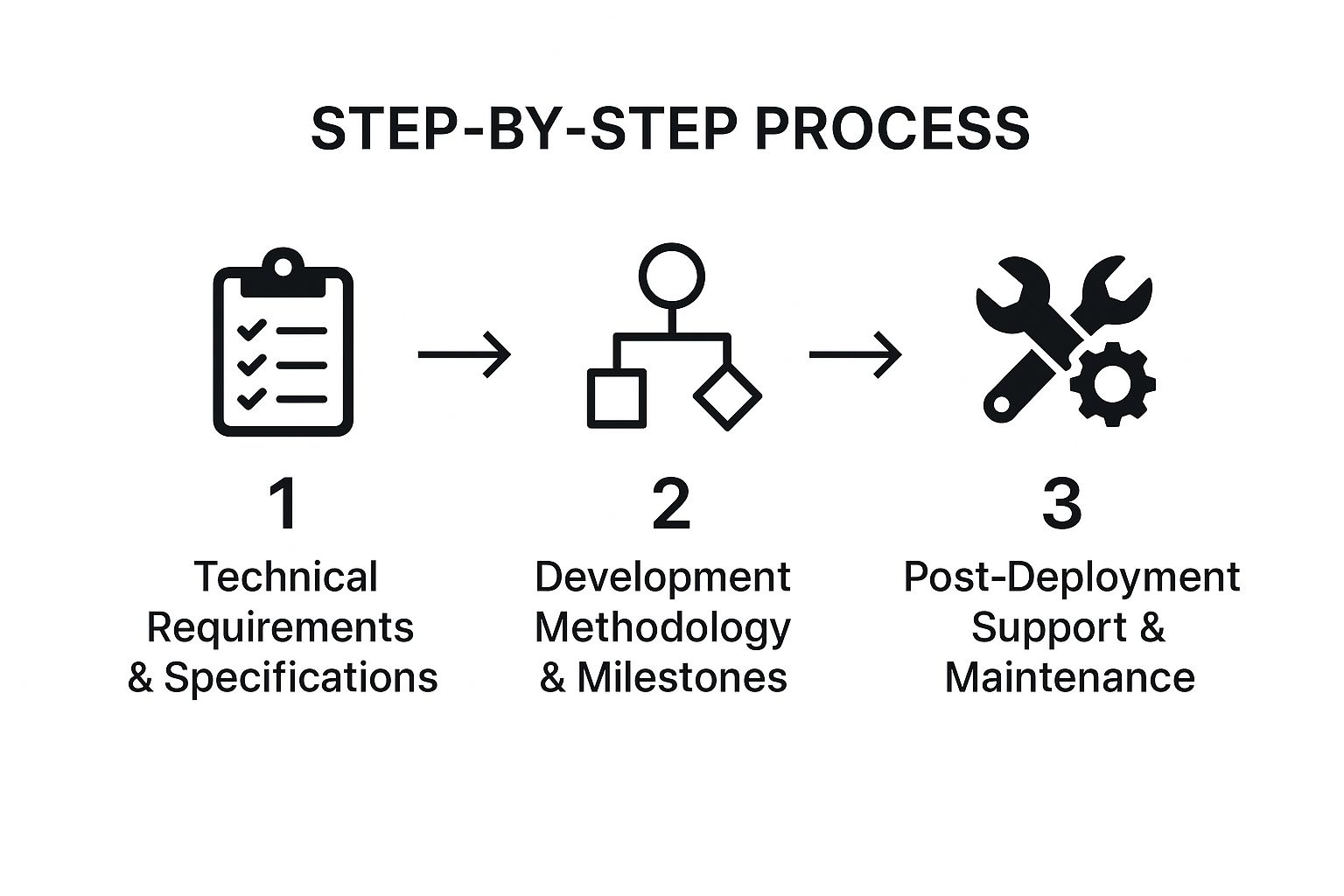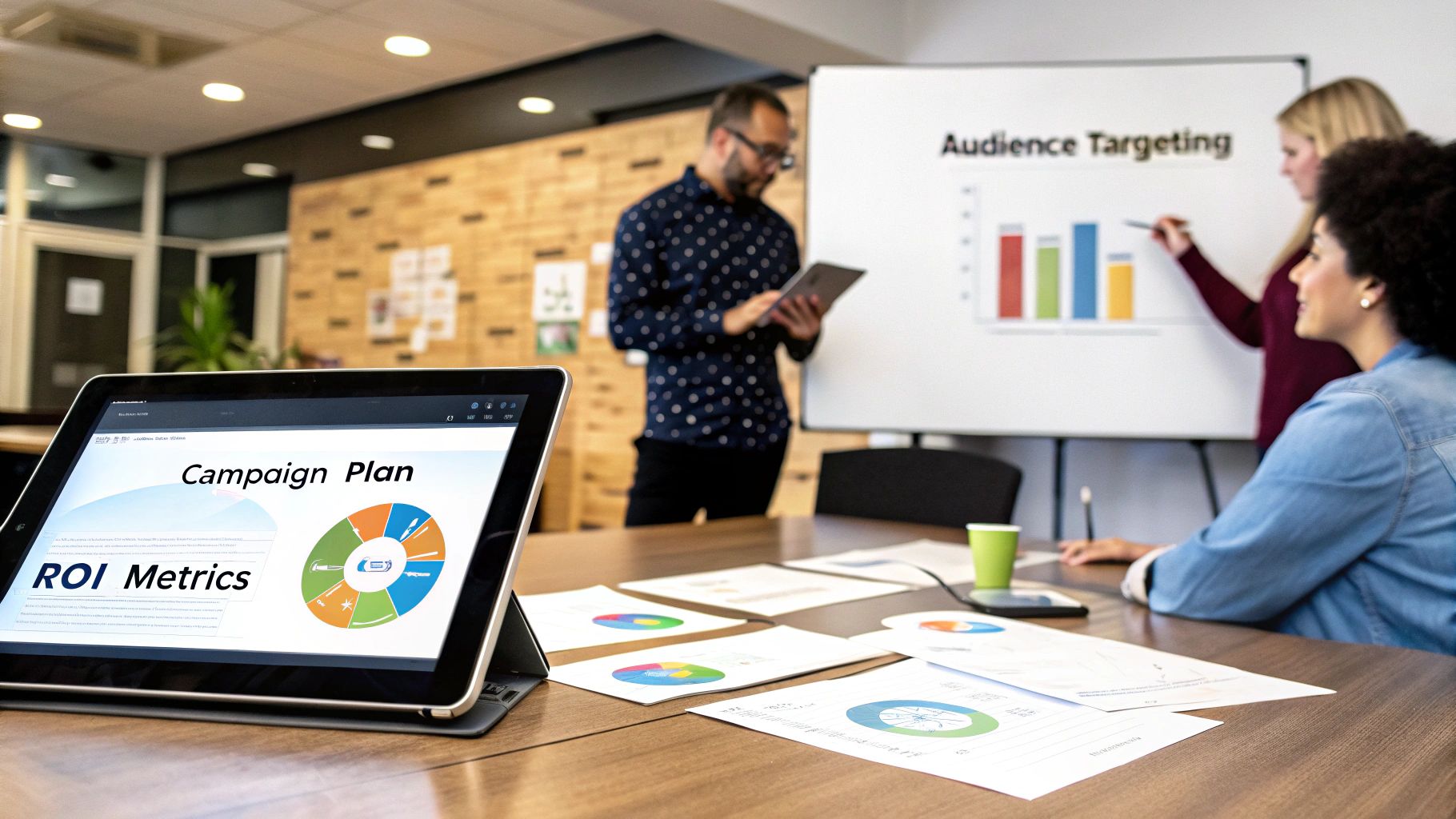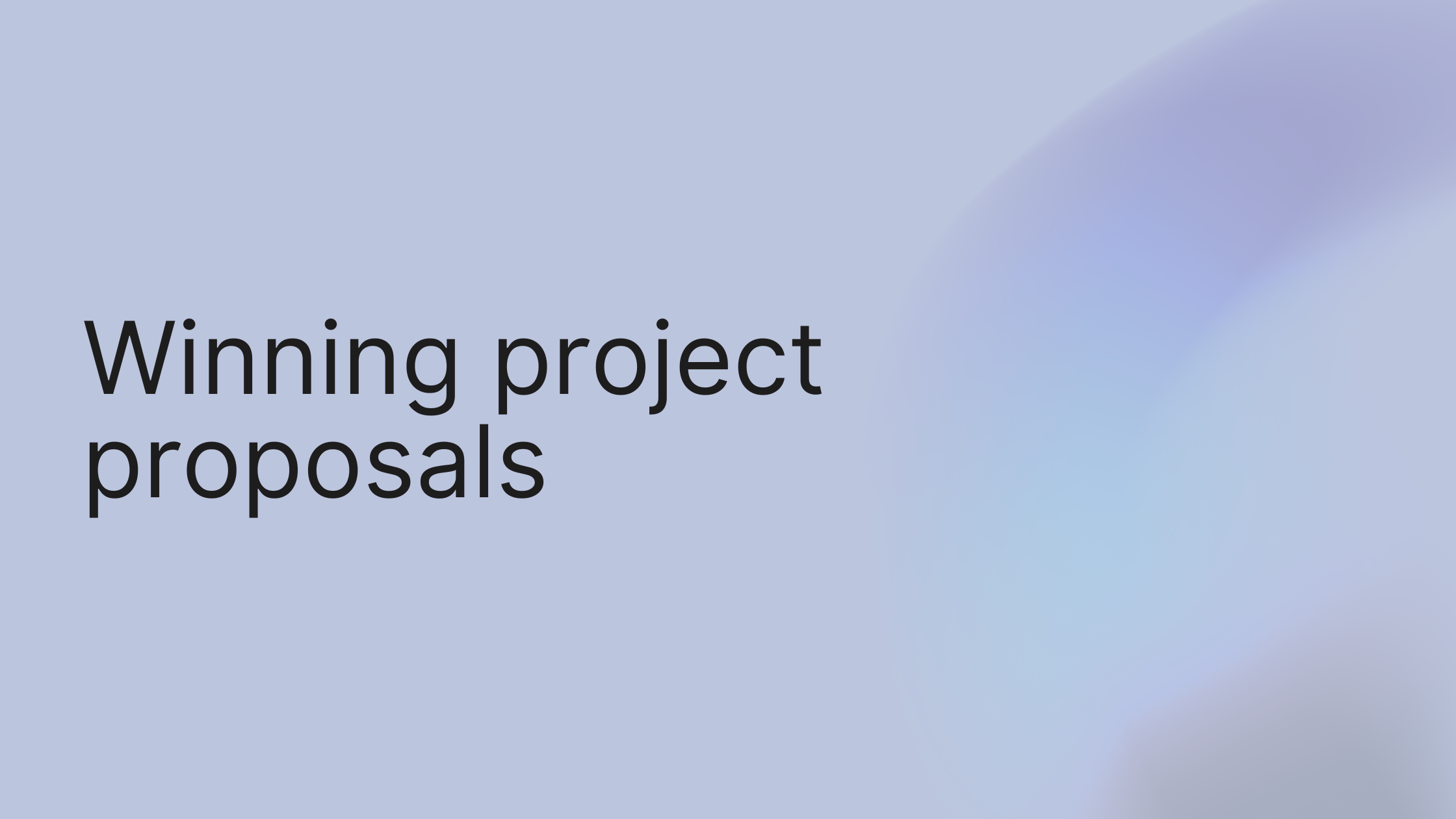Staring at a blank page, trying to create the perfect project proposal? That sinking feeling is universal. You know your solution is a perfect fit, but translating that value into a document that gets a 'yes'—without being too long, too short, or getting ghosted—is a huge challenge.
Here’s a quick win: Before you write a single word, grab a notepad and answer these three questions in one sentence each:
What is the client's specific problem?
What is my direct solution?
What is the tangible result they will get?
This simple framework is your proposal's North Star. It keeps you focused on client value and prevents you from getting lost in details. Now, let’s build on that foundation with actionable examples.
In this guide, we're breaking down six distinct project proposal example formats. We'll provide step-by-step guidance, real-world examples, and replicable strategies you can apply immediately to build proposals that win clients.
Mini Case Study: How a Simple Proposal Won a $50k Web Project
A small agency, "Brightweb," was competing against larger firms for a complete website overhaul for a mid-sized e-commerce company. Their old proposal format was a dense, 20-page document full of technical jargon.
The Change: Following the "problem, solution, result" framework, they opened their new proposal with a single, powerful slide:
Problem: "Your current site loses 60% of mobile users before checkout, costing an estimated $15k/month in lost sales."
Solution: "We will build a responsive, mobile-first website focused on a streamlined 3-click checkout process."
Result: "We project a 30% increase in mobile conversion rates within 90 days, capturing that lost revenue."
The Outcome: The client immediately understood the value. Brightweb won the $50,000 project because their proposal wasn't about features; it was about solving a painful, expensive problem. This clarity cut through the noise and made their offer impossible to ignore.
1. The Software Development Project Proposal: Securing Technical Buy-In
A software development project proposal is a formal document designed to persuade stakeholders and secure funding for a new software initiative. Unlike simpler proposals, this type must meticulously detail the technical architecture, development lifecycle, resource allocation, and potential risks. It serves as the foundational blueprint for projects like a company-wide Microsoft Office 365 migration or the development of a custom CRM for a sales team. The goal is to leave no room for ambiguity and build unshakable confidence in your plan.
Strategic Breakdown
This type of project proposal example excels because it bridges the gap between the IT department and executive decision-makers. It balances deep technical specifications with a clear-eyed view of the return on investment (ROI). For instance, a proposal for a new mobile banking app wouldn't just list the programming languages; it would connect those technical choices to faster performance and enhanced security, which directly impact customer trust and adoption.
Key Takeaway: The most effective software proposals are bilingual. They speak the language of code and sprints to the technical team and the language of revenue, efficiency, and market share to the business leaders.
This process flow visualizes the core structure of a winning software proposal, moving logically from technical foundation to ongoing value.

This visual underscores that a successful project doesn't end at launch; the proposal must account for the entire project lifecycle to demonstrate long-term viability.
Actionable Takeaways
Translate Tech to Value: For every technical feature (e.g., "Implement caching with Redis"), add a business benefit (e.g., "Resulting in a 50% faster page load time, which reduces customer drop-off").
Visualize the End Product: Include wireframes or mockups. A UI screenshot showing a key feature is more powerful than a paragraph of text. Visuals are a universal language that helps all stakeholders envision the final product, which is crucial for managing expectations. For a deeper dive, review these expert tips on how to manage client expectations.
Offer Tiered Budgets: Present a few budget scenarios (e.g., "Essential," "Recommended," and "All-Inclusive") with corresponding feature sets. This empowers stakeholders to make a choice rather than giving a simple yes/no answer.
Pro Tip: Include a "Technical Assumptions" section. List items like "The client will provide all API keys within 5 business days of project kickoff" or "The project will be deployed on AWS infrastructure." This clarifies dependencies and protects you from scope creep later.
2. The Research Grant Proposal: Winning Over Funding Committees
A research grant proposal is a highly structured, formal document submitted to funding agencies like the National Institutes of Health (NIH) or private foundations to secure financial support for research. This type of project proposal example is rigorously academic, demanding a comprehensive literature review, a detailed methodology, a clear budget justification, and a compelling articulation of the potential impact and expected outcomes. Whether for a Gates Foundation global health initiative or an NSF engineering project, the goal is to convince a panel of experts that your research is not only viable and well-planned but also essential and worthy of their limited funds.
Strategic Breakdown
This proposal format is distinguished by its intense focus on scientific or academic rigor and its adherence to the funder’s precise guidelines. Success hinges on demonstrating a deep understanding of the existing body of knowledge and clearly carving out how your project will contribute something new and significant. For instance, a proposal to study a new cancer therapy wouldn’t just describe the lab procedures; it would frame the research within the context of current treatment limitations, supported by preliminary data, to show why this specific investigation is the most logical next step.
Key Takeaway: A winning research grant proposal is a masterclass in persuasion. It convinces reviewers not only of your competence as a researcher but also of the urgency and importance of your specific question, making it feel indispensable to the field's progress.
This approach requires you to think like a reviewer, anticipating their questions and preemptively addressing any potential weaknesses in your plan. You must prove your project is a sound investment that promises a high return in the form of knowledge, innovation, or societal benefit.
Actionable Takeaways
Step 1: Deconstruct the Funder's Mission. Scrutinize the funding announcement and the agency's mission. Explicitly use their key phrases and terminology to show your research directly supports their strategic goals.
Step 2: Present Preliminary Data. Including pilot data, even a small amount, is one of the most powerful ways to prove your hypothesis is plausible and your methodology works. It significantly de-risks the project in the eyes of reviewers.
Step 3: Build a Review Gauntlet. Before submitting, have your proposal reviewed by mentors, colleagues within your field, and at least one person from outside your discipline. This multi-layered feedback will catch everything from technical flaws to unclear language.
Step 4: Craft a Meticulous Budget. Justify every single line item. A detailed, well-reasoned budget shows you are a responsible steward of funds and have thought through the project's practical execution. Connect costs directly to research activities (e.g., "reagents for 500 PCR assays").
3. The Construction Project Proposal: Building a Foundation of Trust
A construction project proposal is a comprehensive document that outlines every facet of a building project, from initial blueprints to the final coat of paint. It goes beyond a simple cost estimate, detailing architectural plans, engineering specifications, material lists, labor schedules, safety protocols, and regulatory compliance. Whether for a large-scale commercial build like those managed by Turner Construction or a local residential development, this type of project proposal example is the bedrock upon which successful projects are built. It must prove your capability while mitigating perceived risks for the client.

Strategic Breakdown
This project proposal example shines because it meticulously manages risk and sets crystal-clear expectations. In an industry where unexpected delays and cost overruns are common, a proposal that proactively addresses these possibilities builds immense credibility. For example, a proposal from Skanska for a new bridge wouldn’t just list the cost of steel; it would include a detailed logistics plan for material delivery, contingency costs for potential supply chain disruptions, and a clear quality control process, demonstrating a mastery of the project's complexities.
Key Takeaway: A winning construction proposal isn't just a sales document; it's a risk management tool. By detailing every potential variable and your plan to manage it, you sell not just a building, but peace of mind.
This comprehensive approach transforms the proposal from a simple quote into a strategic operational plan. It reassures stakeholders that you have anticipated challenges and have the expertise to navigate them effectively, making your bid the safest and most professional choice.
Actionable Takeaways
Step 1: Incorporate a Contingency Fund. Explicitly include a line item for contingency costs (typically 5-10% of the total budget). Explain that this is for unforeseen issues like material price hikes or unexpected site conditions, showing foresight and fiscal responsibility.
Step 2: Detail Your Quality Control. Don't just say you'll deliver quality work. Outline your specific quality control measures, such as milestone inspections, material testing protocols, and a final walkthrough checklist. This provides tangible proof of your commitment to excellence.
Step 3: Visualize the Timeline. Use a Gantt chart to show the project timeline, including key phases, milestones, and dependencies. A visual schedule is far more effective than a block of text for communicating your plan and setting expectations. You can find more insights on presenting visual data effectively through resources like the Associated General Contractors of America.
4. The Marketing Campaign Proposal: Winning Creative and Strategic Approval
A marketing campaign proposal is a persuasive document that details a strategic plan to promote a product, service, or brand. It goes beyond just showcasing catchy slogans or flashy visuals; it's a comprehensive business case. This type of project proposal example must meticulously outline target audience personas, channel strategy, creative concepts, budget allocation, and the key performance indicators (KPIs) for measuring success. Whether launching a new Apple product or a non-profit awareness initiative, the goal is to prove that your campaign is not just creative, but a sound financial investment poised for returns.

Strategic Breakdown
This proposal format is powerful because it balances right-brain creativity with left-brain analytics. It presents the "what" (the big idea) and the "why" (the data-backed strategy) in a single, cohesive story. For instance, a proposal for a new beverage launch wouldn't just present a cool commercial; it would start with market research identifying an untapped Gen Z segment, then explain how the campaign's TikTok-centric media plan and influencer partnerships are specifically designed to capture that exact demographic's attention and drive trial purchases.
Key Takeaway: A winning marketing proposal doesn't just sell an idea; it sells a predictable outcome. It demonstrates a deep understanding of the target audience and provides a clear, logical path from campaign activities to business growth.
This approach transforms a creative pitch from a subjective art piece into a strategic business plan, making it far easier for stakeholders to grant approval with confidence. It clearly shows how creative efforts will move the needle on key business metrics.
Actionable Takeaways
Step 1: Lead with Data, Follow with Creative. Start your proposal with key insights from market research and audience analysis. This grounds your creative concepts in solid evidence, making them seem less like a gamble and more like a calculated move.
Step 2: Provide Tiered Creative Concepts. Instead of a single "take it or leave it" idea, present two or three distinct concepts at different budget levels (e.g., "Safe Bet," "Bold Approach," "Disruptor"). This empowers stakeholders and involves them in the creative process.
Step 3: Map Every Dollar to an Outcome. Use a detailed budget breakdown that links specific expenditures (e.g., ad spend on Instagram) to expected outcomes (e.g., lead generation). For a closer look at optimizing this part of the funnel, get inspired by these best practices for designing a high-converting lead capture form.
Step 4: Include a Crisis Plan. Briefly outline a protocol for responding to negative feedback or unforeseen PR challenges. This shows foresight and reassures clients that you are prepared for any scenario, protecting their brand reputation.
5. The Non-Profit Project Proposal: Inspiring Action and Securing Funding
A non-profit project proposal is a persuasive document crafted to secure grants, donations, or partnerships for initiatives aimed at social good. Unlike corporate proposals focused on ROI, this type must articulate a compelling community need, outline a sustainable plan for social impact, and demonstrate responsible stewardship of funds. It’s the essential tool for launching projects like a local food bank expansion, a new literacy program for underserved youth, or a disaster relief effort by the Red Cross. The goal is to connect a donor’s desire to help with a tangible, well-managed solution.
Strategic Breakdown
This project proposal example stands out because it masterfully balances emotional appeal with logistical rigor. It doesn't just describe a problem; it quantifies it with data and personalizes it with human stories, creating an urgent and undeniable case for support. For example, a proposal for a new homeless shelter wouldn't just state the number of people without housing. It would feature a testimonial from a family that would benefit, paired with hard data on how stable housing reduces long-term social service costs, appealing to both the heart and the head.
Key Takeaway: The most powerful non-profit proposals make the problem personal and the solution practical. They show funders not only why they should care but also how their contribution will create specific, measurable, and lasting change.
The structure of this proposal type moves a potential funder from an emotional connection to a logical conclusion, demonstrating that their investment will be managed effectively to achieve the stated mission.
Actionable Takeaways
Step 1: Lead with the "Why". Start with a compelling story or a startling statistic that illustrates the problem you’re solving. A Habitat for Humanity proposal might open with a short narrative of a family struggling in unsafe housing to immediately ground the project in human impact.
Step 2: Show Measurable Impact. Define clear, quantifiable outcomes. Instead of saying "improve literacy," specify "increase reading proficiency scores by 15% among 50 third-grade students within one academic year." This proves you have a concrete plan for success.
Step 3: Detail Your Financial Story. Provide a transparent, line-item budget and a diversified funding strategy. Show where other funds are coming from (e.g., other grants, individual donations, in-kind support) to demonstrate project viability and community buy-in. To learn more about securing diverse funding streams, check out these insights on non-profit grant writing.
6. The Business Expansion Project Proposal: Charting Your Path to Growth
A business expansion project proposal is a comprehensive strategic document used to justify entering new markets, launching new product lines, or opening new physical locations. Far more than a simple request for funds, it acts as a strategic roadmap. It must present a convincing case built on market research, competitive analysis, operational planning, and detailed financial projections. This is the type of document behind major moves like Starbucks' entry into international markets or a regional retail chain's initiative to open stores in a neighboring state.
Strategic Breakdown
This project proposal example is powerful because it forces a 360-degree view of a growth opportunity. It moves beyond a simple "we should expand" idea and demands a data-driven justification for why, where, and how. For instance, a proposal for a retail brand to expand into a new city wouldn't just state the city's population. It would include demographic analysis, a breakdown of competitor locations and weaknesses, and a site-selection analysis, demonstrating a deep understanding of the target environment.
Key Takeaway: A winning expansion proposal isn't an ask; it's an evidence-based argument. It preemptively answers every question a skeptical CFO or board member might have, from market size and customer acquisition cost to operational scalability and risk mitigation.
The proposal must show a clear, logical progression from market opportunity to profitable execution. This structured approach, often used by top-tier firms, builds confidence and aligns all stakeholders around a single, unified growth strategy.
Actionable Takeaways
Step 1: Provide Tiered Financial Scenarios. Instead of a single projection, present conservative, realistic, and optimistic financial models. This demonstrates foresight and helps stakeholders understand the potential range of outcomes and associated risks.
Step 2: Include a Pilot Program. Suggest a smaller-scale pilot or phased rollout. This de-risks the investment by allowing you to test assumptions, gather real-world data, and refine your strategy before committing to a full-scale launch.
Step 3: Showcase Your Differentiation. Clearly articulate what will make your expansion successful against existing competitors. Use a competitive matrix to visually compare your value proposition, pricing, and market position. For more on structuring persuasive business cases, you can explore these insights on winning consulting services proposals.
Project Proposal Types Comparison
Proposal Type | Implementation Complexity 🔄 | Resource Requirements ⚡ | Expected Outcomes 📊 | Ideal Use Cases 💡 | Key Advantages ⭐ |
|---|---|---|---|---|---|
Software Development Project Proposal | High - involves technical details, methodologies, updates | High - skilled developers, testers, project managers | Clear technical roadmap, secured funding, managed risks | Corporate software projects, app development | Early risk identification, stakeholder buy-in, accountability |
Research Grant Proposal | Very High - strict academic standards, detailed methodology | High - qualified researchers, equipment, institutional support | Funded research, credible findings, scientific advancement | Academic/scientific research, innovation funding | Enhances credibility, enables large-scale studies |
Construction Project Proposal | High - architectural, engineering, compliance complexity | High - specialists, materials, labor, regulatory permits | Secured contracts, regulatory compliance, cost control | Infrastructure, commercial & residential construction | Ensures compliance, reduces delays, resource planning |
Marketing Campaign Proposal | Medium - strategic planning, creative concepts, adjustments | Medium - marketing team, creative resources, budget | Measurable campaign impact, ROI tracking, brand alignment | Product launches, brand awareness, multi-channel campaigns | Clear ROI, coordinated efforts, stakeholder alignment |
Non-Profit Project Proposal | Medium - social impact focus, diverse funding sources | Medium - volunteers, staff, community partners | Social benefits, community engagement, sustainable impact | Social impact projects, community programs | Builds support, diverse funding, measurable social outcomes |
Business Expansion Project Proposal | High - market analysis, financial forecasting, risk plans | High - capital investment, operational resources | Expanded markets, secured financing, growth framework | New markets, product line expansions | Systematic growth, risk mitigation, accountability |
Your Next Step: From Proposal to Project
We've covered a lot of ground, from the technical precision of a software proposal to the emotional pull of a non-profit appeal. Every winning project proposal example here shares a common thread: they are structured, client-focused, and value-driven. They turn a "maybe" into a "yes" by being clear, persuasive, and professional.
But a winning proposal is just the beginning. The real work starts after the client signs. Manually turning that proposal into a contract, a project plan, a time tracker, and an invoice is where things fall apart. It’s inefficient and creates a clunky client experience right after you’ve worked so hard to win their trust.
Ready to streamline your entire process? Don't let a great proposal lead to administrative chaos. Turn your next win into a seamlessly managed project from day one. Start your free growlio account today and see how easy it is to create proposals, get them signed, and manage the entire client lifecycle in one place.
